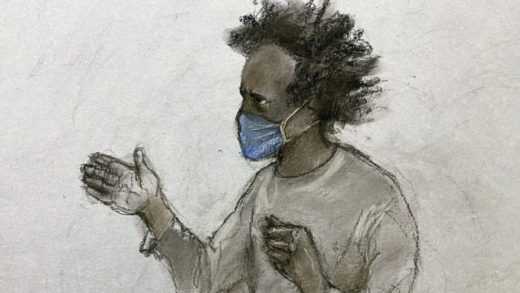MANZANILLO, Cuba, Oct 02 (IPS) – When the weather is bad, the residents of the Litoral neighborhood in Manzanillo, Cuba, are forced to evacuate their houses. When it’s calm, the sea penetrates the foundations of houses, leaving them vulnerable. Now the community is getting together to restore the mangroves and improve the environment to return their homes to safety.Every time a hurricane clouds the skies over the city of Manzanillo, in the eastern Cuban province of Granma, the sea pounds the Litoral neighbourhood, forcing many of the 200 families who live there to evacuate inland because of flooding.
When the weather is calm, the sea penetrates subtly and constantly, salinizing the water table and eroding the coast, affecting the foundations of houses and artesian wells.
“The water almost always enters this area. The houses were built too close to the sea and the mangroves are deforested,” community leader Martha Labrada, 65, told IPS.
Labrada has presided over the people’s council (local administration organisation) for 13 years, which covers the Litoral neighbourhood and a two-kilometer stretch of coastline that is home to about 5,000 people.
Also, in her jurisdiction, about 0.2 square kilometres of mangroves have been deforested or are in very poor condition.

Protective mangroves
According to the United Nations Environment Programme (UNEP), mangroves extract up to five times more carbon than land forests, raise the ground level and thus slow down the rise in sea level.
This coastal ecosystem, typical of tropical and subtropical areas, usually consists of a swamp forest, a strip of black mangrove (Avicennia germinans) and a strip of red mangrove (Rhizophora mangle), the barrier closest to the sea, whose trunks absorb the impact of waves and protect against extreme weather conditions.
Mangroves act as nurseries for fish fry and as havens for honey bees, among a huge variety of fauna and flora.
They also serve as a protective area for fresh water. If degraded, salt from marine waters would more easily enter underground water basins, contaminating the drinkability of this liquid and disabling wells located miles inland.

Protection from the sea
The Litoral neighbourhood is one of the most vulnerable in the municipality to climate change because it borders the mangroves, but it is not the only one in this situation.
In Manzanillo there are six people’s councils that are in direct contact with the coast. Some 60,000 inhabitants suffer the consequences, almost half of the total population of the municipality located 753 kilometres east of Havana.
The need to find solutions to the problem of rising sea levels was therefore born in the rural neighborhoods and villages of Manzanillo.
To counteract this prospect, small community projects emerged in 2018, also promoted by a national plan to tackle climate change known as Tarea Vida, which had been launched by the central government a year earlier.
As a result, 23 initiatives were set up in the municipality, which were later grouped in a single nationwide project called Mi Costa, the project’s coordinator in Manzanillo, Margot Hernández, told IPS.
Mi Costa seeks to create conditions of resilience to climate change through adaptation solutions based on strengthening the benefits provided by coastal ecosystems. In essence, its main task is to reforest and rehabilitate mangroves.
“In addition, we have to change living habits. That’s what we are working on,” Hernández added.

Behind deforestation
Manzanillo, because of its low isometry and its 25 kilometres of coastline, is in a serious state of environmental vulnerability.
The deforested areas of mangroves amount to 708.7 hectares, being the most affected concentrated at the river mouths.
With a weakened natural containment barrier, the saline waters penetrate the riverbeds and, for example, in the Yara River, in the north of the municipality, they do so up to seven kilometres inland, according to Leandro Concepción, the project coordinator for the Granma Provincial Delegation of Hydraulic Resources.
In any case, the salinity penetrates through underground water basins and, according to Hernández, the coordinator in Manzanillo, “there are people’s artesian wells, which were once used for consumption but are now salinized.”
Mangrove deforestation has several causes: the lack or blockage of channels hinders the ebb and flow of the tide and alters the exchange of freshwater with marine waters.
It is also affected by the invasion of invasive exotic species such as the arboreal Ipil Ipil or guaje (Leucaena leucocephala), anthropogenic human intervention through the construction of infrastructure, agricultural and livestock practices near the coast, and even the felling of mangroves to make charcoal.

According to Labrada, the community leader in Litoral, several houses have been built almost adjacent to the mangrove, without the corresponding construction permits. Moreover, state-owned industrial infrastructures, such as a shoe factory and an inactive sawmill, cause the same damage.
Coastal and river pollution from industrial waste dumping also depresses coastal ecosystems.
For decades, the region’s sugar mills and rice industry dumped their waste into the rivers, Blanca Estrada, administrative coordinator of Mi Costa on behalf of the Granma provincial government, told IPS.
This situation is one of the examples of climate injustice in the area: upstream, the industrial sector caused environmental havoc that affected mangrove health and, at the end of the chain, the quality of life of coastal residents, making them more vulnerable to climatic events.
In 2023, decisive measures were taken to solve the problem and the few active factories no longer discharge their waste into the sea or use filters. In the second half of 2024, the results have already begun to show: “The migratory birds have returned, something you didn’t see months ago,” said Estrada.
However, the effects of climate change still persist in Manzanillo.
“The environmental situation today is quite complex for the keys,” Víctor Remón, director of Manzanillo’s Department of Territorial Development, which belongs to the local government, told IPS.
The municipality’s territory contains an extensive cay of 2.44 square kilometres, but Cayo Perla has already been submerged under the waters of the Gulf of Guacanayabo.
“It disappeared six or seven years ago. It was a beautiful key, with beautiful white sands. There was a tourist facility from where you could see the city of Manzanillo,” Remón said.
For his part, Roberto David Rosales, fisherman and Mi Costa contributor, remembers a path he used to walk along the shore until last year; now it has been ‘swallowed’ by the sea.
“Almost two meters were lost in this area in one year. These are things that force us to be protectors of the mangroves. The Mi Costa project came at the right time,” he told IPS.

Steps towards a solution
Mi Costa was made official in December 2021, but heavy work began in 2023, due to a pause caused by the COVID pandemic.
In Manzanillo, the project brought together about 100 collaborators, who were divided into small community groups of about 10 people, who support the monitoring and cleaning of mangroves and ditches and awareness-raising among the population.
Labrada also has its own people’s council group, composed of six women and four men.
In addition, training centres have been set up in the municipality on climate change adaptability, environmental safeguards, gender and other issues. To date, 10,500 people have been trained.
“We are working with the coast dwellers, because the issue is that people don’t leave the coasts, but that they stay and learn to live there, taking care of them,” said Estrada, the government coordinator.

They have also built 1,300 meters of ditches, using picks and shovels, to achieve a form of water rotation, but this figure has yet to be multiplied.
The immediate challenge is to finish building the nursery where the mangrove seedlings will sprout and then be planted in the deforested areas.
“Once we have the nursery, there will be no difficulty at all in Granma to begin the process of rehabilitating the mangroves,” Norvelis Reyes, Mi Costa’s main coordinator in the province, told IPS.
Mi Costa’s area of action in Granma covers, in addition to the coast of Manzanillo, the northern municipalities of Yara and Río Cauto.
Nationwide, 24 communities in the south of Cuba are involved in resilience actions (1,300 kilometres of coastline), of which 14 are at risk of disappearing due to coastal flooding by 2050, including Manzanillo.
The southern coast of this Caribbean island country was chosen because it is more vulnerable to climate change and sea level rise, given its lower geographical isometry than in the north.
In addition, the south also has a higher concentration of mangroves, making it more necessary and effective to build coastal resilience based on adaptation and focused on the rehabilitation and reforestation of these ecosystems.
While implemented by the communities themselves and with the participation of the villagers, the project is supervised by the Ministry of Science, Technology and Environment and the country office of the United Nations Development Programme (UNDP).
The Green Climate Fund provided funding of USD 23.9 million, while Cuban state institutions contributed USD 20.3 million.
The ultimate goal will be to restore some 114 square kilometres of mangroves, 31 square kilometres of swamp forest and nine square kilometres of grassy swamps in eight years. After that, a period of 22 years will be dedicated to the operation and maintenance of the implemented actions.
It is estimated that more than 1.3 million people will benefit on this Caribbean island, the largest in the region and home to 11 million people.
UN Bureau Report
Follow @IPSNewsUNBureau
Follow IPS News UN Bureau on Instagram
© Inter Press Service (2024) — All Rights ReservedOriginal source: Inter Press Service
Source link
#Cubas #Coastal #Dwellers #Mitigate #Effects #Climate #Change


















